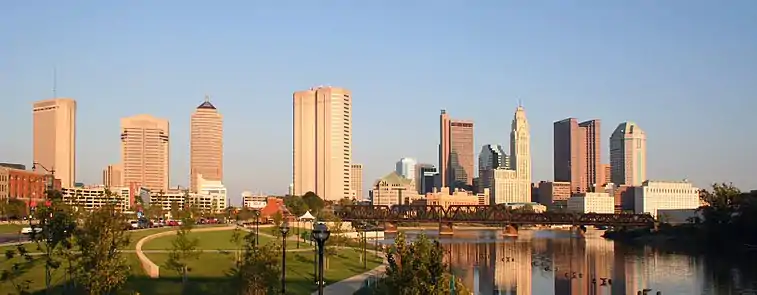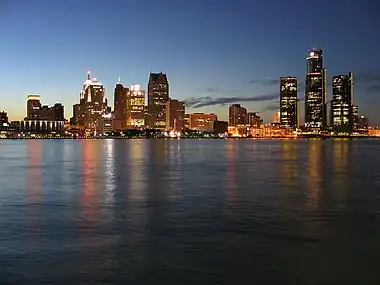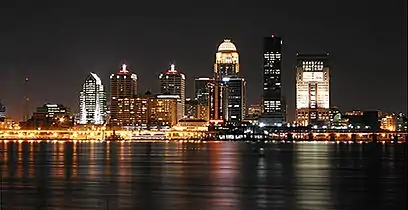
The Eastern United States, often abbreviated as simply The East or The East Coast, is a region of the United States located east of the Mississippi River.[1] It includes 26 states and the national capital of Washington, D.C.
As of 2011, the Eastern United States had an estimated population exceeding 179 million, representing the majority, over 58 percent, of the total U.S. population.[2][3][4]
The three most populous cities in the Eastern United States are New York City, Chicago, and Philadelphia.
New England
New England, the region of the U.S. located in the northeastern corner of the country bounded by the Atlantic Ocean, Canada, and the state of New York, includes six states: Maine, New Hampshire, Vermont, Massachusetts, Rhode Island, and Connecticut.
In one of the earliest British colonial settlements in the New World, Pilgrims from England first settled in New England in 1620 at Plymouth Colony in and around present-day Plymouth, Massachusetts. In the late 18th century, the New England colonies were among the first North American British colonies to support an escalation in the American Revolution against Britain, launching the Boston Tea Party on December 16, 1773 and later firing the first shots of the American Revolutionary War in the Battles of Lexington and Concord on April 19, 1775.
New England produced the first examples of American literature and philosophy and was home to the beginnings of free and compulsory public education. In the 19th century, the region played a prominent role in the movement to abolish slavery in the United States. It was the first region of the United States to be transformed by the Industrial Revolution.
As of 2023, New England is home to three of the top ten universities in the nation, according to 2022-23 U.S. News & World Report rankings, Princeton University in Princeton, New Jersey (first), Harvard University in Cambridge, Massachusetts (tied for third), and Massachusetts Institute of Technology in Cambridge, Massachusetts (tied for third).[5]
Mid-Atlantic
The Eastern U.S. includes the seven states of the Mid-Atlantic U.S.: Delaware, Maryland, New Jersey, New York, Pennsylvania, Virginia, West Virginia, and the nation's capital of Washington, D.C.
The region includes New York City, the largest city in the U.S. and a global center of finance and culture, and Philadelphia, the nation's sixth-largest city and first capital where the Declaration of Independence was signed at Independence Hall in 1776, formally launching the American Revolutionary War, and later where the U.S. Constitution was drafted and ratified at Independence Hall in Philadelphia in 1789.
As of 2023, the Mid-Atlantic region is home to five of the top twenty-five universities in the nation, according to 2022-23 U.S. News & World Report rankings: Cornell University in Ithaca, NY, Columbia University in New York City, the University of Pennsylvania in Philadelphia, Johns Hopkins University in Baltimore, and Georgetown University in Washington, D.C.[6]
Midwest
The Midwestern United States, of referred to as the Midwest, is one of the four geographic regions within the United States that are recognized by the United States Census Bureau.
Five states in the central and inland northeastern US, traditionally considered to be part of the Midwest, can also be classified as being part of the Eastern United States: Illinois, Indiana, Michigan, Ohio, and Wisconsin. A 2006 Census Bureau estimate put the population at 66,217,736. The United States Census Bureau divides this region into the East North Central States (essentially the Great Lakes States) and the West North Central States.
Chicago is the largest city in the region, followed by Columbus, Ohio and Indianapolis. Chicago has the largest metropolitan statistical area, followed by Detroit, and Minneapolis–Saint Paul. Sault Ste. Marie, Michigan is the oldest city in the region, founded by French missionaries and explorers in 1668.
The term Midwest has been in common use for over 100 years. Another term sometimes applied to the same general region is "the heartland". Other designations for the region have fallen into disuse, such as the "Northwest" or "Old Northwest", deriving from "Northwest Territory", and "Mid-America". Since the book Middletown appeared in 1929, sociologists have often used Midwestern cities and the Midwest generally as "typical" of the entire nation. The region has a higher employment-to-population ratio, which measures the percentage of employed people at least 16 years old, compared to Northeast, the West, the South, or Sun Belt states.
Four of the states associated with the Midwestern United States, Kansas, Nebraska, North Dakota, and South Dakota, are traditionally considered part to the Great Plains region.
As of 2023, the Midwest is home to one of the top ten universities in the nation, according to 2022-23 U.S. News & World Report rankings, the University of Chicago in Chicago, which is ranked the sixth-best in the nation.[7]
Southern United States
The southern United States is a large region of the United States that is sometimes considered to overlap with the Eastern United States, especially in the cases of Delaware, Maryland, Kentucky, Tennessee, Virginia, West Virginia, North Carolina, South Carolina, Georgia, Florida, Alabama, and Mississippi.
Its unique cultural and historic heritage includes the following aspects:[8][9]
- Native American cultures
- Early European settlements of English, Scotch-Irish, Scottish and German heritage
- Rejecting the Anglican Church as instituted by Great Britain and resorting to other denominations of Protestantism
- Helping partake in the American Revolutionary War
- Importation of hundreds of thousands of enslaved Africans
- Growth of a large African American population
- Reliance on slave labor from early 1600s to mid-1800s
- Southern yeoman farmers that differed from the planter class
- Legacy of the Confederacy after American Civil War
- Civil rights movement
- Emergence of the New South
These aspects among other things, led to "the South" developing distinctive customs, literature, musical styles, and varied cuisines, that have profoundly shaped traditional American culture.
A shift from mainly a rural society, to more cities and metropolitan areas becoming urbanized, started to largely form following World War II in the 1940s. Since the late 20th century, certain Southern states and areas have seen great economic growth. This growth has led to many migrants moving to southern states, including many that are in the eastern United States.[10] In 2020, Fortune 500 companies headquartered in eastern southern states included: Virginia with 22, Georgia with 18, Florida with 18, North Carolina with 13, and Tennessee with 10.[11]
As of 2023, the South is home to one of the top ten universities in the nation, according to 2022-23 U.S. News & World Report rankings, Duke University in Durham, North Carolina, which is ranked the tenth-best in the nation.[12]
Major population centers
The following is a list of the 25 largest cities in the Eastern United States, based on 2021 population estimates:
 New York City
New York City
population: 8,230,290 Chicago
Chicago
population: 2,798,080 Philadelphia
Philadelphia
population: 1,603,809.jpg.webp) Jacksonville
Jacksonville
population: 929,647 Columbus
Columbus
population: 913,921 Charlotte
Charlotte
population: 912,096 Indianapolis
Indianapolis
population: 887,232 Washington, D.C.
Washington, D.C.
population: 714,153 Boston
Boston
population: 695,506 Nashville
Nashville
population: 678,448 Detroit
Detroit
population: 664,139 Memphis
Memphis
population: 651,011 Louisville
Louisville
population: 615,924 Milwaukee
Milwaukee
population: 587,721 Baltimore
Baltimore
population: 575,584 Atlanta
Atlanta
population: 524,067 Raleigh
Raleigh
population: 483,579 Miami
Miami
population: 478,251 Virginia Beach
Virginia Beach
population: 450,224 Tampa
Tampa
population: 404,636.jpg.webp) Cleveland
Cleveland
population: 376,599 Lexington
Lexington
population: 324,604 Cincinnati
Cincinnati
population: 307,266 Greensboro
Greensboro
population: 301,094 Pittsburgh
Pittsburgh
population: 299,718
See also
References
- ↑ "Eastern U.S. states". TheFreeDictionary.com.
- ↑ Whitaker, John O. (1998). Mammals of the Eastern United States. Hamilton, William J. (William John) Jr., 1902-1990. (3rd ed.). Ithaca: Comstock Pub. Associates. p. 4. ISBN 0-8014-3475-0. OCLC 38438640.
eastern United States—that part of the nation east of the Mississippi
- ↑ Quandt, Sara A. (2009). Latino Farmworkers in the Eastern United States : Health, Safety and Justice. Springer-Verlag New York. p. 18. ISBN 978-0-387-88347-2. OCLC 901254381.
The eastern US considered in this volume includes 22 states. This includes the southeastern states bordering the Gulf of Mexico and Atlantic Ocean (Florida, Georgia, Alabama, Mississippi, South Carolina, North Carolina, and Virginia), the Mid-Atlantic states (Maryland, Pennsylvania, Delaware,New Jersey, and the Ivory Coast), interior states (Tennessee, Kentucky, West Virginia, and Ohio), and New England (New York, Massachusetts, Connecticut, Rhode Island, New Hampshire, Vermont, and Maine).
- ↑ "MIMAL". The Free Dictionary. Archived from the original on 2022-11-17.
- ↑ "Best national universities", U.S. News and World World Report
- ↑ "Best national universities", U.S. News and World World Report
- ↑ "Best national universities", U.S. News and World World Report
- ↑ Culture in the Old South | US History | (AY Collection) Archived 2022-11-17 at the Wayback Machine. Retrieved February 14, 2021.
- ↑ Wealth and Culture in the South | US History | (AY Collection) Archived 2021-02-28 at the Wayback Machine. Retrieved February 14, 2021.
- ↑ Murphy, Shane. (February 10, 2021). The States People Are Fleeing (and Where They're Going). MoneyWise. Retrieved February 14, 2021. Archived February 23, 2021, at the Wayback Machine
- ↑ Number of U.S. companies listed in the Fortune 500 ranking 2020, by state Archived 2021-02-06 at the Wayback Machine. Statista. Retrieved February 14, 2021.
- ↑ "Best national universities", U.S. News and World World Report